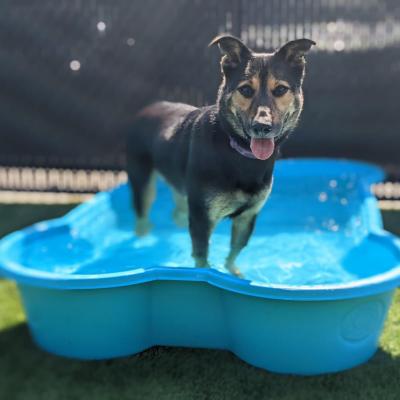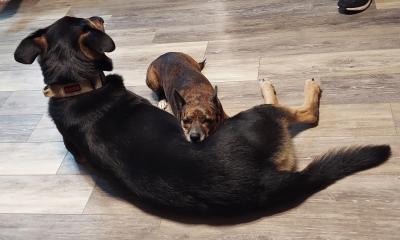The sixth time’s the charm for an energetic dog

Moose loves to play fetch for hours. He loves playing in the pool, too. Sometimes he combines his two loves and plays fetch from the pool. When he was at Best Friends in Los Angeles, he had many fans; volunteers considered him a dream hiking buddy, and he loved being around people and being on the move.
He was just 4 years old when he came to Best Friends, sweet, happy, and bursting with energy. And so he quickly was adopted. But then he was brought back to Best Friends. He got adopted again. And was brought back again. And again. And again. And again.
[Two false starts lead dog to true love]
Moose was such a sweetheart, so social and friendly with people and other dogs, that Ana Pulido, Best Friends coordinator of lifesaving outcomes in Los Angeles, figured the second adoption would be the charm — then the third had to be. But it wasn’t. He went through five adoptions and subsequent returns in a year. What was going wrong?
“There wasn’t really any big behavioral reason,” says Ana. “Moose was a really happy, great dog. But he was a dog who needed a long time to settle after a transition.” In other words, Moose didn’t handle change well. A combination of separation anxiety in a home and general anxiety overall, along with a sensitive temperament, made adjusting to any new routine challenging for Moose.

Impulse control helps a dog with anxiety
Moose was bursting with energy, and that coupled with his anxiety sometimes meant he had more energy than people were prepared for. And although Moose is social and appeared to like other dogs, his combination of high energy and anxiety caused him to guard people or toys from other dogs in the home.
Ana and the Best Friends staff recognized that Moose needed a lot of mental stimulation and exercise. And that meant he needed a lot of training in addition to those hours of fetch. So finding the right people for Moose would mean finding people who could provide the level of training and exercise that Moose needed.
In the meantime, Moose’s stress increased each time he left Best Friends and came back. Highly nervous when left alone, he barked constantly. He was so on edge that he couldn’t wait for a staff member to set his bowl of food down to eat; he slurped up half his dinner while the bowl was still mid-air.
To counter this behavior and give him mental stimulation, Ana and the other caregivers worked with Moose on impulse control. Feeding him was one such training opportunity. And because Moose was attentive and intelligent, he picked up on the training quickly, learning to wait a moment for food or to go to places and so on.
It took some time, but the training helped Moose considerably. Eventually, people were able to walk by Moose without him barking. He could finally settle on his bed. That was something Kathryn Stoney noticed right away when she came to Best Friends looking for a dog to adopt as a companion for her family’s dog.

Family shows dog he’s where he belongs
The Stoneys had lost their 12-year-old dog, an integral part of their family and best friend to their younger dog. When they went to Best Friends to adopt, they had Moose already in mind. “We loved that Moose had a calm and sweet demeanor,” Kathryn says. And it was that calm, sweet demeanor and the fact that Moose played easily with their dog, along with knowing that for the past three months no one had taken an interest in adopting him, that did it. The Stoneys were Moose’s sixth adoption — the one that would stick.
[Anxious dog goes home with his kindred spirit]
Best Friends staff had made them aware of Moose’s anxiety and coached them on how to help him. To ease Moose’s separation anxiety while they were at work, the Stoneys turned on some white noise, blocked the windows so that Moose couldn’t see movement outside, and made him a comfy bed to curl up in. That, plus his new dog buddy to play with, helped him relax.
When they came home, they took Moose out for fetch and a walk. After the first two weeks, his anxiety ebbed. He embraced his new routine, which involved his favorite thing: fetch — not just from the pool but on the beach, too. “Beach Saturdays are his favorite as he loves to run along the waves and swim in the water,” says Kathryn.

Dog’s true personality flourishes
Ana, her fellow caregivers, and volunteers knew Moose’s potential. And they knew it could be hard for potential adopters to recognize. During Moose’s time at Best Friends, they saw how Moose’s anxious barking and behavior made people exclaim, “Oh, he’s way too much.” But Ana says, “It’s important to understand that the kennel environment is not the normal home environment.”
She says the best thing that adopters can do is talk with staff and learn about the dog like the Stoneys did. With some work, consistency, and love, the sixth time was the charm. The Stoneys found an amazing addition to their family: the kind, friendly, playful Moose.

Give them the best day, week or lifetime ever
For a homeless pet, there’s not much better than finally having a family. And you can give them that.
Read more
A story of love and learning with an anxious dog